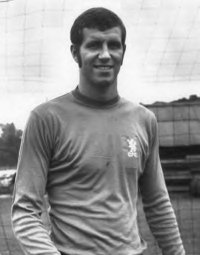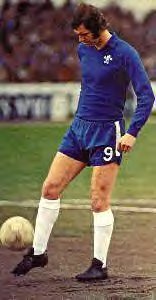Nationality: British
Position
D.O.B.: 20th February 1947, Windsor
Time Spent With Chelsea: 1964-1974, 1978-1979
Other Clubs: Southampton, Norwich City, Philadelphia (USA)
Signed From: Brought through Chelsea Juniors.
Cost: -
Debut: December 1964 - Workington (H)
Number of Appearances: 379 (150 goals)
Departed Chelsea: 1979
International Record: (Under-23’s 6 appearances (4 goals) – (Full 4 appearances))
Where are they now?: Match day representative at Southampton (St Mary’s).
Peter Leslie Osgood was the “King of Stamford Bridge” – the idol of The Shed. The instinctive crowd-pleaser, Osgood would glide past defenders with contemptuous ease before smashing or stroking the ball home.
Terrific, tall, lean and elegant, Ossie was excellent in the air and equally deadly on the ground. He has been described as a phenomenon. Peter had everything, power skill and pace. 
Born at Windsor in 1947, Ossie was undoubtedly one of the most talented and exciting players of his generation.
Having signed from the junior ranks, where he was prolific, he progressed through the first team ranks signing professional forms in September 1964, where he matured sufficiently to warrant a place in the first eleven. As he scored goal after goal, he became one of the most wanted centre forwards in the English game.
Brian Mears (former Chelsea Chairman), marvelled at the talents of Osgood:
“The world was just an amusement park for Peter Osgood. He was the leader of the Chelsea set. An emerging Kings Road dandy, Osgood could take his place alongside those other London All stars, Mick and Keith from the Stones, Ron and Reggie in the Blind Beggar…….Osgood epitomised swinging London as much as David Bailey or Paul McCartney, celebrating and celebrated, inaccessibly cool…..he had everything.”
It wasn’t long before the delicate artistry and goalscoring power of Chelsea’s gentle giant stamped him as a regular. Peter, at the height of his creative power was Docherty’s great white hope. In a blaze of publicity Docherty moved Bridges, then the English centre-forward, to the wing to accommodate Osgood in the number nine berth. Tommy Docherty let him know that, baring injury, he was to be played in ten consecutive games, irrespective of his performances.
Osgood soon repaid his faith. After an “uncertain” start, the glint of brilliance was there for all to see. Osgood was to become a dominant force. Docherty’s decision to keep Osgood in the team proving inspired.
However, just when it seemed a glittering career was gathering momentum, fate struck a cruel blow in a league cup tie at Blackpool in October 1966.
Brian Mears recalls the incident on that fateful night:
“Osgood broke his leg that stormy night in a sickening clash with Emlyn Hughes. Osgood always had a strong sense of self preservation. He had clashed with Hughes early in the game and was preparing for another crunching tackle. The break was very, very bad. Osgood despite the great career he was still to have at Stamford Bridge was in my view, the same player again. Those close to him would later notice a slight change in his character. On the field he was always looking for the tackle first. The Chelsea striker never recovered the killer burst of pace he had before the accident. Osgood retained his own pavonine skills which were both arrogant and effortlessly brilliant, but they acted as a smokescreen for the psychological battle he had lost within himself.”
The extent of Osgood’s injury was such that many thought he would be lucky to walk again, let alone play at the highest level.
Upon Osgood’s return to the team and return to the goal scoring form so prominently displayed prior to his horrific injury, Osgood himself noted a difference to his own game:
“When I came back I didn’t go past people as quickly as I used to. I came from a big family, was still growing as a lad and put one or two stone in weight as well, which is a lot. You’ll never know how different a player I became.”
However, Ossie continued his irrepressible form and he won his first England cap against Belgium in Brussels in March 1970.
Sources:
“Chelsea – Football Under the Blue Flag” (Brian Mears and Ian Macleay) ISBN: 1-84018-432-9
“Upfront with Chelsea” (Chris Westcott) ISBN: 1-84018-450-7
“The Stamford Bridge Encyclopedia” (Paul Harrison) ISBN: 1-85158-749-7